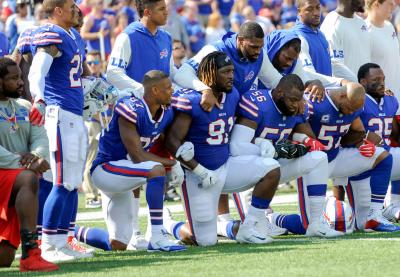Within the lines of the First Amendment, there is room. Room to stand—or kneel—for self-defined virtues and constitutionally defined rights. Room for interpretation. Room for context. Room for growth.
But in the classroom, there is little margin for error by omission. As professional athletes and allies #TakeAKnee, educators may not have the option to sit out the discussion surrounding peaceful protests during the national anthem.
Here’s the context you need to teach this moment and connect it to the United States’ history of peaceful protest and opposition.
Why are people taking a knee during the national anthem?
At the beginning of the NFL’s 2016 season, Colin Kaepernick, then a quarterback with the San Francisco 49ers, took a knee during the “Star Spangled Banner.” When asked why he kneeled during the anthem, Kaepernick stated, “I am not going to stand up to show pride in a flag for a country that oppresses black people and people of color. ... There are bodies in the street and people getting paid leave and getting away with murder.”
Kaepernick's decision to kneel, rather than sit on the bench, was inspired by a conversation with a former NFL player and Green Beret who saw it as a more respectful gesture toward the military.
In keeping with a long tradition of athletes protesting social issues, Kaepernick decided to use his platform to draw attention to police violence against people of color and the lack of accountability for police officers. Since then, Kaepernick has received both widespread support and criticism for his chosen form of protest. Now, a year later, Kaepernick finds himself without a team for the season amidst allegations that he is being blackballed from the NFL for his beliefs. Many players, including international athletes, have decided to kneel in solidarity with Kaepernick and otherwise show support. And the protest has spread to the larger realm of sports: from baseball to peewee football and high school soccer.
The protests escalated this past weekend after President Trump encouraged owners of NFL teams to fire players who refused to stand during the national anthem. Ben Watson, a tight end for the Baltimore Ravens, was one of the players who protested this past weekend. “Obviously, the name-calling is something we don't [stand] for,” he said, “but even to imply that we don't have the right to express ourselves in that way is something that we really took to heart.” Entire teams refused to come onto the field for the anthem; others knelt en masse. For the first time since the beginning of the protest, team owners and coaches linked arms and protested with their players as a show of collective action to shine attention on the original message: the unjust killing of people of color and the lack of accountability for police officers who commit these acts.
How is this form of protest connected to protests from the past?
#TakeAKnee has direct ties to the civil rights movement of the 1950s and ‘60s. For example, the civil rights campaign in Birmingham, Alabama, was effective in large part because of its public nature. Television viewers around the world could see nonviolent protesters being brutalized by police officers using water hoses, dogs, and billy clubs. The same goes for peaceful protesters in Selma. In both of these moments, the catalyst for change was television. Today, much of Sunday television is dominated by full-day coverage of NFL games on major networks and sports channels. Today’s protests, much like those of the past, are meant to encourage meaningful dialogue and action by making viewers uncomfortable. As with protests of the past, that discomfort isn’t a bad thing.
Backlash to the civil rights activism often led to threats and very real acts of violence, surges in white supremacist ideals and imagery, and an outpour of “us versus them” rhetoric. Today, resistance comes in the forms of demanding protesters be fired and changing the narrative of the protest to be about the American flag and U.S. troops and veterans, as opposed to police brutality and injustice against people of color.
Protests have almost always been met with resistance. For example, a 1961 Gallup poll found that 61 percent of respondents disapproved of the Freedom Rides, and 57 percent believed that civil rights demonstrations hurt the integration cause. In many ways, that resistance is the point. Change usually occurs through these clashes of ideals. Civil rights activism of the past shares an underlying theme with today’s activism: Injustice can only be ignored for so long before everyone has to face it, whether it’s on the nightly news or during a Sunday NFL broadcast.
Discussion Questions
- Why might an athlete choose to participate in this form of protest? Why might an athlete choose not to participate?
- Is there a “proper” time or place for engaging in collective action? What’s the significance of this action taking place at sporting events?
- The concerns raised by Colin Kaepernick aren’t new, so why are these protests sparking such attention now?
- How does this form of collective action connect to past movements?
- What role might empathy play in helping people to understand the oppression at the center of these protests?
- What could people do beyond taking a knee to help address the concerns behind that action?
Additional Resources
What Is Your Reaction to President Trump’s Tweets About Professional Sports Leagues and Athletes?
Part-Time Indian and Colin Kaepernick

